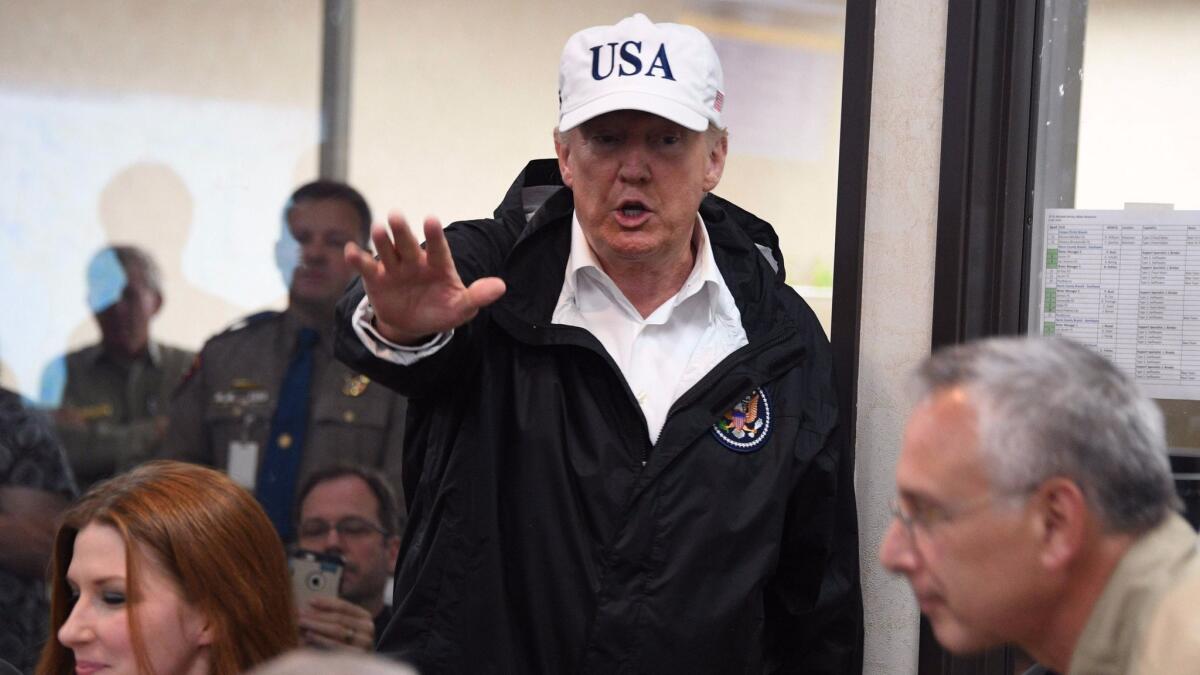Perspective: How Harvey is giving us a break from our pundit addiction
- Share via
Something unusual happened to national television news this week. News.
Footage of reporters in soggy rain slickers and melting baseball caps, waist-deep in brackish water, delivering minute-by-minute accounts from flooded boulevards in Beaumont, Texas, packed evacuation centers in Houston, and harrowing boat and helicopter rescues in Corpus Christi and Cuero.
Interviews with fire department chiefs and meteorologists replaced the usual prime-time political panels on CNN. Reports of a levee breach ate up MSNBC airtime usually reserved for analysts’ deconstruction of President Trump’s latest gaffe.
The media fixation with Trump and itself refocused on real news overnight, or at least over the weekend, and all it took was a Category 4 hurricane that FEMA authorities have labeled more devastating than 2005’s Katrina to push us there. Essentially, Tropical Storm Harvey altered the landscape of Texas, and for a few days at least, the national news media.
From CBS News to Fox, news outlets rediscovered journalism. They offered researched overviews on the impact of the storm — the human toll, monetary damages, the ecological impact — and up-close, personal accounts. One photojournalist, for instance, documented a group’s evacuation in a small boat as it floated past the submerged Le Chic Beauty Academy.

The impact of the slow-moving storm is so widespread and tragic that TV media need not mine the same story for new angles, as many have done over the past year in order to provide nonstop coverage of the Trump presidency. Anywhere they point a camera or check in with a local affiliate station in South Texas or Louisiana, there’s a new development due to record-breaking rainfall.
It was a bracing reminder of the true power of the press. No accusations of false news here, we could see it with our own eyes. A burly Texan reduced to tears when he’s reunited with his dog. A frail grandmother airlifted from her rooftop, pink purse in her hand. Reporters becoming part of the story by helping pull storm victims from the surge.
Even CNN dispensed with its go-to panels on whatever Trump just did or didn’t say in favor of real reportage from outside their New York or Washington studios.
It’s hard to remember the last time 24-7 cable news devoted so much time, and so many resources, to a subject other than the dysfunction in Washington, and before that, the insanity of the longest presidential campaign in the history of unbearably long campaigns.
While watching Harvey unfold in real time, the value of round-the-clock TV news all of a sudden became clear again. Wall-to-wall coverage of a disaster of this magnitude would be impossible to cover in any sort of comprehensive way via short YouTube clips, social media posts or traditional one-hour newscasts.
And it’s a story not likely to fade out quickly. Unlike an earthquake or terror attack, where the destruction and devastation is immediate, the aftereffects of Harvey, like the water the system has and will produce, keeps arriving in waves.
The cameras were also rolling during Hurricane Sandy in 2012, and Katrina before that. But this feels different, or at least our mind-set does given that we’ve become so addicted to the hourly mini-crisis and beltway machinations that keep Rachel Maddow and Sean Hannity employed.
We’ve grown used to “news” that’s manufactured out of the opinions of hosts and experts for hire. Harvey is a not-so-subtle reminder that national news is still local, even though a handful of national outlets have come to represent what we think of as the nexus of American Media.

The past few days of TV broadcasts have been such an abrupt change from All Trump All the Time, even the president himself seemed taken aback that he didn’t get more attention for his controversial pardon of the former sheriff of Maricopa County, Ariz., on Friday, the day Harvey struck.
“I assumed the ratings would be far higher than they would be normally — the hurricane was just starting,” Trump said Monday.
On Tuesday when he flew to Texas with the first lady to speak to Texans affected by the storm, he still addressed the crowd as if it were there to see him: “Thank you everybody. What a crowd. What a turnout!”
He vowed the storm recovery would be “better than ever before.”
Last week his comments would have been picked apart ad nauseam by news personalities, and the clip run every 15 minutes behind a “Breaking News!” banner.
That’s not to say they aren’t being analyzed by a CNN panel this very moment, or defended by Fox’s “The Five,” but they didn’t get front or even second billing during Tuesday’s newscasts. (The North Korean missile tests over Japan got second billing, another actual news story).
Instead, that threadbare, overused banner was applied to stories that fulfilled the promise of breaking news.
In all the arguments about what qualifies as fake news, the shift of the media during Harvey is a clear example of the difference between spin and journalism. One is news filtered through analysts, commentators or a ratings-minded, network-wide vision, the other is the stuff journalists have been doing since before your great-great-grandparents were born. Reporting the news.
ALSO
Like New Orleans after Katrina, Houston faces heartbreak, resilience and recovery following Harvey
Gulf Coast braces for more rain as Harvey makes second landfall
Watch Coldplay dedicate new song to Harvey victims -- and vow never to play it again
More to Read
Only good movies
Get the Indie Focus newsletter, Mark Olsen's weekly guide to the world of cinema.
You may occasionally receive promotional content from the Los Angeles Times.











